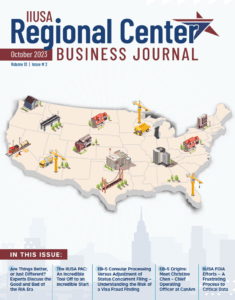The Association to Invest In the USA (IIUSA) represents 190 Regional Center members that together account for over 95% of the economic activity occurring in the United States through the EB-5 Regional Center Program in diverse communities across the country. According to a peer-reviewed economic impact study, tn fiscal year 2012 alone EB-5 investments contributed over $3.39 billion to gross domestic product (GDP), supported over 42,000 U.S. jobs, and generated $712 million in federal/state/local tax revenue – all at no cost to the U.S. taxpayer. Investor demand continues to be at an all-time high according to fiscal year 2013 and Q1-2 fiscal year 2014 data.
On May 9, at the 2014 annual Board of Directors meeting, the IIUSA Board of Directors affirmed the industry’s consensus policy platform:
After 20+ years & nine extensions, time to permanently authorize the EB-5 Regional Center Program
Congress must act soon to permanently authorize the EB-5 Regional Center Program before its current “sunset” date of September 30, 2015, providing the certainty needed to maximize the Program’s economic benefit for the U.S. Strong bipartisan support has defined all nine re-authorizations to date, including 2012 with unanimous support in the Senate and 412-3 vote in the House – while also removing the word “pilot” for the statute. With economic impact setting records, and strong growth after more than twenty years in existence, a permanent EB-5 Regional Center Program is “an idea whose time has come.”
Maximize the economic impact of the Program through expanded visa availability
It is essential that visa availability increase before a backlog occurs at the expense of the American economy. Solutions that have bipartisan support, and which have already been approved by either the House or Senate this Congress, include counting only the principal applicant towards the annual visa cap, removal of per-country caps on all employment-based immigrant visas, recapturing unused visas from past years and increasing EB-5 visa allocations based on demand-all of those options would increase the economic impact of the Program.
Ensure efficient, predictable and transparent processing of EB-5 applications and petitions
Congress must ensure that the U.S. Citizenship & Immigration Services (USCIS) has the necessary resources and expertise to administer an efficient, predictable, transparent, and secure processing system for the EB-5 Regional Center Program. Reliable processing times are essential for the success of this Program in creating U.S. jobs. We are confident the agency is capable of adjudicating petitions efficiently and thoroughly. To ensure USCIS has the resources needed to address the large backlog of EB-5 investor petitions, Congress must exercise its oversight responsibilities to establish more predictable and efficient processing of petitions. There are currently over 6,000 investor applications pending at USCIS, representing $3.0 billion in capital investment that will create over 60,000 American jobs at no cost to the taxpayer.
Support inter-agency collaboration and industry self-regulation to protect program integrity
In tandem with industry efforts to self-regulate by establishing best practices, Congress must support efforts at the agency level to ensure law enforcement responsibilities are being handled by the appropriate federal authorities while also ensuring the necessary resources are available to punish bad actors and deter fraud.
Maintain state authority to designate the geography of target employment areas (TEAs)
State governments are best suited to determine a geography’s merit for definition of “high unemployment.” Bringing a federal agency into the TEA determination process is unnecessary and will likely result in further delays of EB-5 adjudication. Similarly, expanding the authority for TEA designation to the local level (municipal and/or county) would create confusion, various applications of standards, and slow down the process of projects getting approval that overlap jurisdictions.
Competitive minimum investment amount with phased implementation of changes
Any potential increase in the minimum capital investment for immigrant investors should be done so not to disrupt current investment flows and discourage investment. Any changes in this regard must have a phased implementation that is fair to those already actively investing through the Program in order to maintain Program integrity.









